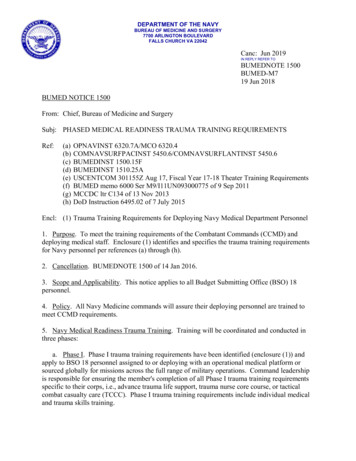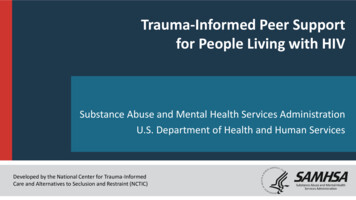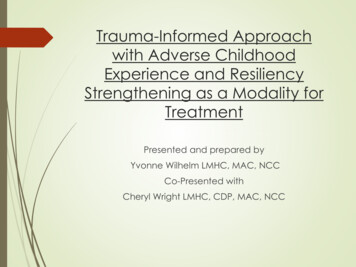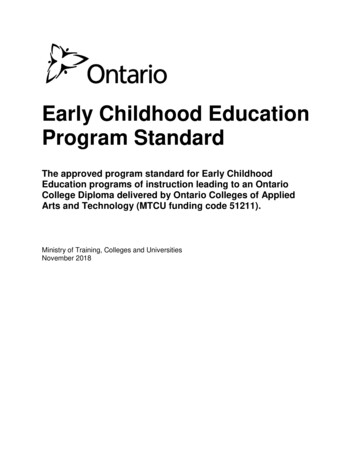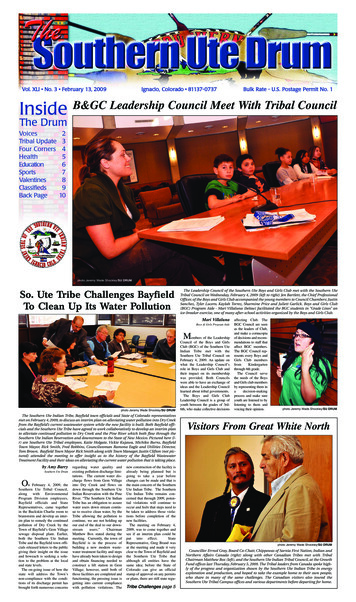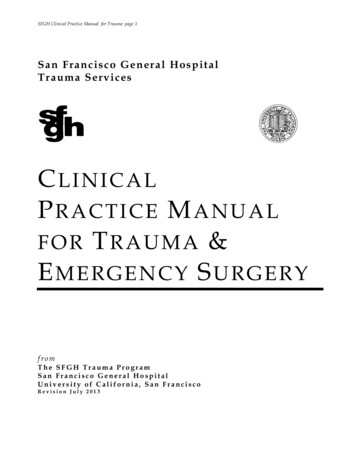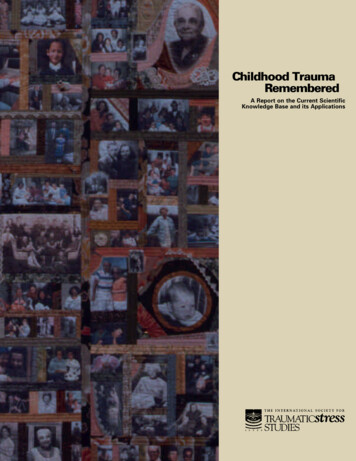
Transcription
Childhood TraumaRememberedA Report on the Current ScientificKnowledge Base and its Applications
Childhood TraumaRememberedA Report on the Current ScientificKnowledge Base and its ApplicationsChief Editors:Susan Roth, PhDDuke University, Durham, NCMatthew J. Friedman,MD, PhDNational Center for PTSD, Veteran’s Affairs Medical Center, White River Junction, VTDartmouth Medical School, Hanover, NHSection Editors (in consecutive order):David Finkelhor, PhDFamily Research Lab, University of New Hampshire, Durham,NHLinda Williams, PhDStone Center, Wellesley Centers for Women,Wellesley College, Wellesley, MAMatthew J. Friedman,MD, PhDNational Center for PTSD, Veteran’s Affairs Medical Center, White River Junction, VTDartmouth Medical School, Hanover, NHLucy Berliner, MSWHarborview Center for Sexual Assault and Traumatic Stress, Seattle, WASandra L. Bloom,MDAlliance for Creative Development, P.C., Quakertown, PAContributors (in alphabetical order):Victoria L. Banyard, PhDUniversity of New Hampshire, Durham,NHChristine Courtois, PhDPrivate Practice and The Psychiatric Institute, Washington, DCDiana Elliot, PhDHarbor-UCLA Medical Center, Torrance, CAIra Hyman, PhDWestern Washington University, Bellingham, WADebra L. Rubin,MSS,MLSP, LSWWomen’s Law Project, Philadelphia, PADaniel Schacter, PhDHarvard University, Cambridge, MAJonathan W. Schooler, PhDUniversity of Pittsburgh, Pittsburgh, PASteven Southwick,MDNational Center for PTSD, West Haven,CTYale University Medical School, New Haven,CTCarol Tracy, JDWomen’s Law Project, Philadelphia, PABessel A. van der Kolk,MDBoston University School of Medicine, Boston,MAThis document is endorsed by the International Society for Traumatic Stress Studies,and was prepared with the help of headquarters staff, ISTSS Immediate Past PresidentTerence Keane, PhD, and Journal of Traumatic Stress past and present editors,Bonnie Green, PhD and Dean Kilpatrick, PhD.For reprint requests or additional copies, contact ISTSS at 60 Revere Drive, Suite 500, Northbrook,IL 60062; telephone:847/480-9028; fax:847/480-9282;e-mail: istss@istss.org.Cover art: Beebe’s Birthday 1993 by Ami Simms. This wall quilt features over 180 photographs and otherimages that have been transferred to fabric. Simms made the quilt for her mother’s 70th birthday. It is featured withother photo-quilts in Simms’ book, Creating Scrapbook Quilts (Mallery Press, 1993). For more information aboutSimms’ quilts, books, or Photos-To-Fabric TM transfer paper, please call 800/278-4824, or write to Mallery Press at4206 Sheraton Drive, Flint, MI 48532-3557.
INTRODUCTIONver the past several years, the topic of memories of childhood trauma, particularly childhood abuse, has led to considerable debateamong professionals and nonprofessionals alike. The debate hasattracted the attention of the popular media, which has both reflected andcreated a wide-ranging interest in questions relating to the memory, inadulthood, of traumatic experiences in childhood.OThe degree of popular and professional interest in questions about thevalidity of memories of childhood abuse has helped to establish a culturalbackdrop against which personal, clinical and legal issues for survivors ofchildhood abuse are considered. On the one hand, a considerable amountof attention has been drawn to the prevalence and enduring effects of theabuse of children by adults who control their access to nurturance, love andmaterial resources. On the other hand, an air of suspicion often surroundsaccounts of recovered memories of childhood trauma, whether they occurin response to cues or triggers in the popular media, in psychotherapy, inthe courtroom or in response to family life. For the most part, what hasbeen missing in the public eye is a balanced report on the current scientificknowledge base relating to memories of childhood trauma, and the implications of this knowledge base for clinical and forensic practice. The purpose of this report is to provide that information in a readily accessible way.The initiative for this report comes from the leadership of the InternationalSociety for Traumatic Stress Studies, with strong support from its membership. The Society (ISTSS) is perhaps uniquely prepared to take on the taskof gathering the expertise necessary to present the state of the art in scientific understanding about memories of childhood trauma.ISTSS is a professional organization of worldwide influence which is dedicated to the discovery and dissemination of knowledge and to the stimulation of policy,program and service initiatives that relate to the occurrence and consequences of traumatic stress. For the present document, we have receivedinput from some of the most distinguished clinical researchers and scholarson traumatic memory in order to provide you with the best availableknowledge and its most thoughtful practical application.The International Society for Traumatic Stress Studies1
Additional Reading forIntroductionBelow are reports of professionalorganizations on the topic ofmemories of childhood abuse:Alpert, J., Brown ,L . , Ceci,S.,Courtois, C., Loftus, E., &Ornstein, P. (1996). Working groupon the investigation of memories ofchildhood abuse: Final report.Washington, DC: AmericanPsychological Association.2American Medical Association.Memories of Childhood AbuseReport of the Council on ScientificAffairs (CSA Report 5-A-94).American PsychiatricAssociation. Statement onMemories of Sexual Abuseapproved by the Board ofTrustees of the AmericanPsychiatric Association onDecember 12,1993.Hammond,D.C. et al.(1994).Clinical hypnosis and memory:Guidelines for clinicians and forforensic hypnosis.AmericanSociety of Clinical Hypnosis Press.Recovered memories. TheReport of the Working Party ofthe British Psychological Society(1996). In Pezdek,K.& Banks,W. (Eds.), The recovered memory/false memory debate. NewYork: The Academic Press.Childhood Trauma RememberedThis report is organized into five short sections. In the first section, accumulated scientific findings about the prevalence of childhood trauma andits psychological consequences are discussed, and the relationship of thesefindings to the traditions of trauma-focused psychotherapy and assessmentis explained. In the second section, the scientific evidence for the forgettingof childhood traumatic events, for the delayed recall of traumatic eventsafter a period of forgetting, and for “false memories” of childhood trauma ispresented. This section is the center of our report, and the remaining threesections provide the elaboration and application of the information presented here. In the third section, what cognitive psychologists and neurobiologists understand about human memory is outlined, based on recent scientific discoveries, and then the implications of this research for an understanding of traumatic memories in general, and forgetting and delayedrecall of traumatic events in particular are described. Finally, in the fourthand fifth sections, the focus is on how to best apply this current knowledgein clinical and forensic practice with trauma survivors. Gaps in the knowledge base are also identified.This report represents and incorporates the work of a diverse group ofscholars with expertise in a variety of different topic areas and professionalcontexts. It is a statement of the state-of-the-science that is expected toevolve as new information becomes available. Finally, this effort is in keeping with what has been produced by other professional organizations (seereports at left), and is in the spirit of finding middle ground and a convergence of various points of view and areas of expertise.This report is not meant to be a comprehensive research review, but ratheran overall summary of the major issues involved in the recall of childhoodtrauma. Therefore, instead of the usual format of citing specific referencesfor each issue, representative references and suggested readings are listed asa sidebar for each section.
SECTION IPREVALENCE AND CONSEQUENCES OF CHILDHOOD TRAUMAltogether too many children experience serious traumas in childhood. Major accidents from cars or fire, involving broken bones orconcussions, are common. Children also unfortunately experiencelife-threatening diseases such as cancers, leukemia and systemic infections.Some children get caught up in natural and human-made disasters likeearthquakes, floods, wars or ethnic persecution. Children experience violence in their communities; they get kidnapped, raped or watch assaults onothers. And although much of this was once hidden from public view, weknow today that children are too often the victims of battery or sexualabuse by those taking care of them, or are witnesses to episodes of abusiveviolence between parents.AWe do not know the exact number of children who experience serious trauma, but given the variety of forms it can take, the number is not small. Inrecent years, many efforts have been made to estimate the occurrence ofparticular kinds of childhood trauma. Sexual abuse is the type of traumathat has received the greatest amount of study. The estimate that 20% ofgirls and 5-10% of boys experience such unwanted sexual contact andmolestation while growing up is based on a large number of communityepidemiological studies that have interviewed adults about their childhoods. It appears that only a fraction of these cases get disclosed to authorities while they are occurring, which accounts in part for why only approximately 300,000 cases get reported to U.S. child welfare authorities each year.Both science and personal experience tell us that these childhood events sometimes leave scars that last until adulthood and interfere with healthy adult functioning. It is one of the most consistent scientific research findings that traumasand adversities in childhood tend to put an individual at risk for a large varietyof later difficulties. This is true for all kinds of early traumas, including accidents, disasters and the observation of violence. But we know it to be especiallytrue for victims of child abuse and neglect, who have been the subject of a particularly large amount of research. Those who were severely abused as childrenare two to five times more likely to experience a mental illness as an adult thanthose who were not. They are more likely to suffer from low self-esteem anddifficulties in social, academic and occupational performance. Children whowere abused or neglected are also more likely to get caught up in patterns oflater delinquent and criminal behavior, violence, alcohol and drug abuse.The International Society for Traumatic Stress Studies3
Additional Reading for Section IBriere, J. & Elliott, D. (1994).Immediate and long-termimpacts of child sexual abuse. TheFuture of Children, 4 (2),pp. 54-69.This article reviews evidenceabout the long-term impact ofearly traumatic sexual abuse.4Finkelhor, D. (1994). Currentinformation on the scope andnature of child sexual abuse. TheFuture of Children, 4 (2),pp. 31-35.This article reviews evidence onthe prevalence of childhood sexualabuse in the general population.U.S. Department of Health andHuman Services. (1997). Childmaltreatment 1995. Reports fromthe states to the National ChildAbuse and Neglect Data System,Contract no. ACF-105-95-1849.Washington, DC: U.S.Government Printing Office.This publication provides themost recent information on thelarge numbers of child abusecases currently being reportedand investigated by state agencies.Childhood Trauma RememberedOf course, the relationship between childhood traumas and later difficultiesis not a simple or inevitable one. Not all traumatized or maltreated childrenby any means suffer from later problems. Many recover, sometimes veryquickly, and have successful lives. And some traumatized children sufferlater problems not directly due to their trauma, but due to other factorssuch as poverty or genetic vulnerabilities that put them at risk for trauma inthe first place. But overall, the weight of research evidence points verystrongly toward childhood trauma as one important causative factor in lateradult maladaptive functioning.Given that childhood trauma can play such an important role in adultproblems, most psychotherapeutic approaches currently in practice carrythe assumption that it is important and even essential to gather a comprehensive trauma history in order to plan treatment. The details surroundingtraumatic experiences can provide clues to the depth and seriousness of aperson’s difficulties. Knowledge about these traumas and some of their possible effects can also help therapists in formulating the kinds of correctiveexperiences that might alleviate current distress and maladaptive patternsof functioning. While it is not certain that trauma-focused treatments arenecessarily better than other kinds of treatment for trauma survivors, andwhile controlled studies are just now being done with many trauma populations for the first time, research has nevertheless shown trauma-focusedtreatments to be effective. Patients report relief from anxiety and depression, and resolution of intrusive thoughts and feelings about traumaticchildhood events. The practices of trauma-focused assessment and psychotherapy have grown in popularity in recent years for these reasons, andwe will return to this topic in Section IV.
SECTION IIDELAYED RECALL OF TRAUMATIC EVENTSAFTER A PERIOD OF FORGETTINGt the root of the debate about memories of childhood trauma is thequestion of how common it is for adults to fail to recall traumas thatoccurred in childhood. People forget myriad ordinary experiences,but do people forget childhood trauma? While there is a period in infancyand early childhood during which scientists don’t expect memory for any lifeevents, the debate about recovered memory centers on traumas that occurredafter this period of approximately the first two or three years of life.AEvidence for the forgetting of childhood traumaEvidence that people forget childhood traumas comes from clinical andnonclinical studies, and encompasses a range of traumas. The evidence isnot limited to people in treatment or to people whose trauma is sexualabuse. Clinical reports of trauma-related forgetting in individual patientscan be found in psychiatric literature spanning the last hundred years. Inthe last 10 years, scholarship on this topic has included research with largerclinical samples of women and men in treatment for the consequences ofsexual abuse. This research reveals that many adults who recall childhoodsexual abuse report prior periods during which they did not remember theabuse. Recent scholarship has also included nonclinical samples of adultswho report a broader range of traumas, and here, too, there are reports ofhigh rates of prior periods of forgetting. One difficulty with these studies isthat reports of prior forgetting are also subject to memory problems. Wecannot assume that individuals’ assessments of their prior forgetting arenecessarily accurate. Prospective studies of documented abuse that evaluatecurrent forgetting suggest, however, that a significant proportion of womenand men with documented cases of sexual abuse in childhood do notappear to recall the documented incident when reinterviewed as youngadults. Some of the research findings from retrospective and prospectivestudies are summarized below and on the next page.Evidence for Forgetting Childhood Traumas Herman & Schatzow (1987) found that 28% oftheir clinical sample of women in group therapy for incest reported “severe memorydeficits” for their abuse. Briere & Conte (1993) found that 59% of 450 women and men intreatment for sexual abuse reported that, at some time prior to age18, they had forgotten the sexual abuse they suffered during childhood.The International Society for Traumatic Stress Studies5
Additional Reading for Section IIHyman,I., Husband, T. H., &Billings, F. J. (1995). False memories of childhood experiences.Applied Cognitive Psychology, 9,pp. 181-197.This paper provides evidence thatindividuals can be made to believethat they had unusual childhoodexperiences that did not actuallyoccur. After a third suggestiveinterview, 25% of the subjectsclaimed to recall events that hadnot occurred.6Hyman,L.E.& Pentland, J.(1996). The role of mentalimagery in the creation of falsechildhood memories. Journal ofMemory and Language, 35,pp. 101-117.This article provides evidence thatindividuals who are asked to forma mental image of an event and todescribe it to an interviewer weremore likely to create a false event.They were also more likely torecover memories of a previouslyunavailable true event.Childhood Trauma Remembered Loftus, Polonsky & Fullilove (1994) reported that 31% of theirsample of sexually abused women in treatment for substance abusereported at least partial forgetting or incomplete memory for theirabuse. 19% reported prior periods of total lack of recall of the abuse. Elliot (1997), in a national, stratified, random sample of 505women and men, found that 20% of the 116 people in thesample who reported a history of childhood sexual abuse saidthat there was a period of time when they had no memory ofthe event. Complete to partial forgetting was reported afterevery form of traumatic experience, with child sexual abuse,witnessing a murder of a family member and combat exposureyielding the highest rates. Williams (1994), and Williams & Banyard (1997) followed upwomen and men who, in the early 1970s, were seen in a hospitalemergency room for child sexual abuse. They found that at thetime of their study, which was 17 years later, 38% of the womenand 55% of the men did not recall the documented abuse. Ofthe women who did recall the abuse, 16% stated that there was atime in the past when they did not remember that it had happened to them. Widom & Morris (1997) found that 32% to 60% of women and58% to 100% of men with court-substantiated reports of childsexual victimization did not report such abuse on reinterviewsome 20 years later.It should be noted that the above findings have been challenged in anumber of critiques that address methodological concerns with theretrospective studies as well as with the Williams study (see Pope &Hudson, 1995).Sources: Herman, J. L., & Schatzow, E.(1987). Recovery and verification of memories of childhood sexual trauma. Psychoanalytic Psychology, 4, pp. 1-14; Briere, J. &Conte, J. (1993). Self-reported amnesia for abuse in adults molested as children.Journal of Traumatic Stress, 6, pp. 21-31; Loftus, E., Polonsky, S. & Fullilove, M. T.(1994). Memories of childhood sexual abuse: Remembering and repressing.Psychology of Women Quarterly, 18, pp. 67-84; Elliot, D. M.(1997). Traumaticevents: Prevalence and delayed recall in the general population. Journal ofConsulting and Clinical Psychology, 65, pp. 811-820; Williams, L.M.(1994). Recallof childhood trauma: A prospective study of women’s memories of child sexualabuse. Journal of Consulting and Clinical Psychology, 62, pp. 1167-1176; Williams, L.M.(1995). Recovered memories of abuse in women with documented child sexualvictimization histories. Journal of Traumatic Stress, 8, pp. 649-675; Williams, L .M . &Banyard,V. L.(1997). Gender and recall of child sexual abuse: A prospective study.In Read, J. D. & Lindsay, D. S .( Eds.), Recollections of traum a :S c ientific evidence andclinical practice, pp. 371-377. New York: Plenum Press; Widom ,C .S . , & Morris, S.(1997). Accuracy of adult recollections of childhood victimization: Part 2:Childhood sexual abuse. Psychological Assessment, 9, pp. 34-36.
Evidence for delayed recall of trauma after a period of forgettingIf we accept the evidence that a significant minority of people do in factforget childhood trauma, at least for some period of time, then other interesting questions arise. When people report that they recall instances ofchildhood trauma that they had previously forgotten, clinicians andresearchers have been interested in the factors relating to this “delayedrecall,” and in the accuracy of these “recovered memories.” Research findings suggest that age at the time of the childhood trauma is associated withforgetting, and that those who were younger are more likely to have forgotten and to report recovered memories. A wide variety of triggers seem to beassociated with the recovery of memory for childhood trauma, includingwatching a television program or reading some materials about trauma,undergoing a similar experience at a later time, and discussions with familyand friends. It is likely that situations that have some characteristics that aresimilar to the original event are associated with recovered memories.Interestingly, a majority of recovered memories are reported to occur outside of therapy.Additional Reading for Section IILoftus, E. F. & Pickrell, J. E.(1995). The formation of falsememories. Psychiatric Annals,25(12), pp. 720-725.Regarding the accuracy of recovered memories, several cases in the publicrecord of reported delayed recall of childhood abuse that were corroboratedprovide evidence for accuracy, as do preliminary studies of recovered memories of documented traumatic events that occurred in childhood. In theresearch project mentioned above, for example, Williams was able to compare women’s current accounts of their abuse with the details of the abusethat had been recorded in the 1970s. She found that the women who reported prior periods of forgetting and the experience of having recovered memories, and those who had always remembered had the same number of discrepancies when their accounts of the abuse were compared to the reportsfrom 17 years earlier. This evidence suggests that memories of childhoodtrauma can become accessible after periods of forgetting. A summary andsynthesis of more than two dozen studies on trauma-related forgetting isdescribed in Scheflin and Brown.This article provides a thoughtfulmethodological analysis of the limitations of studies concerning forgetting of childhood sexual abuseand constructive suggestions forthe design of future studies.This paper relies on the “lost inshopping mall” paradigm to showthat adults could lead a child tobelieve that he or she had been lostin a shopping mall, suggesting thatmemories of at least one mildlytraumatic event can be implanted.Pope, H.G.& Hudson, J. I.(1995). Can memories of childhood sexual abuse be repressed?Psychological Medicine, 25,pp. 121-126.Scheflin ,A . W. & Brown, D. (1996).Repressed memory of dissociativeamnesia: What the science says.Journal of Psychiatry and Law, 24(2), pp. 143-188.This paper presents a summary andsynthesis of more than two dozenstudies on trauma-related forgetting.The International Society for Traumatic Stress Studies7
Additional Reading for Section IISchooler, J. W. Bendiksen.M. &Ambadar, Z.(1997) Taking themiddle line: Can we accommodate both fabricated and recovered memories of sexual abuse?In M. Conway (Ed.), False andrecovered memories, pp. 251-292.Oxford: Oxford University Press.8This paper provides evidence ofrecovered memories and alsoreports that some individuals mayexaggerate their prior forgetting,believing they had forgotten abouttheir abuse during periods inwhich they are known to havetalked about it.Williams, L.M.& Banyard, V. L.(1997). Perspectives on adultmemories of childhood sexualabuse:A research review. InSpiegel, D. (Ed.). Section IIAmerican Psychiatric Review ofPsychiatry, 16, Chapter 9, pp. II123 to II-151.This chapter provides a review ofempirical evidence that supportsthe likelihood that child sexualabuse can be forgotten, that memories of abuse can be implantedand that memories of abuse onceforgotten can be recovered.Childhood Trauma RememberedThere is no scientific evidence that adults are likely to intentionally fabricateallegations of abuse in childhood when surveyed using standard victimizationscreening techniques, or when reporting abuse histories to friends, family ortherapists. However, a critical question is whether some proportion of reported accounts of recovered memories of childhood trauma, although sincere, areinaccurate (i.e., what have been called “false memories”).Evidence that memories can be implantedA large body of laboratory research on memory and suggestibility supportsthe position that memory is reconstructive and imperfect, that memory canbe influenced and distorted, that confabulation can occur to fill in memorygaps, and that subjects can be persuaded to believe they heard, saw or experienced events which they did not. Evidence has accumulated that inaccuratememories can be strongly believed and convincingly described. Much of thelaboratory research on suggestibility of memory has involved paradigms inwhich subjects view an event in which they are not a participant, are laterprovided incorrect information about the event and, finally, are asked aboutwhat they saw. Incorrect information is likely to be incorporated in the laterreports of memories of the event. This is termed the “misinformation effect,”and it is argued that this effect applies as well to memories for experiences ofchildhood trauma or child sexual abuse. It is asserted that similar processesmay lead to a client’s false belief that he or she was sexually abused or otherwise traumatized if such a history is suggested by a therapist.Criticisms of the application of laboratory research to questions of memoryof childhood trauma in general, and to child sexual abuse specifically, havefocused on the ecological validity of the studies (i.e., their applicability tothe real world experience of trauma experienced in childhood, and childmolestation and its aftermath). Changing or adding a feature to an event, asis the procedure in much of the laboratory research, is not the same as causing someone to believe that an entire new event occurred. Critics haveargued that implanting memories for traumatic events, and generally forevents in which one is a participant, may be a very different matter. Ofcourse, research ethics preclude any experiment that would attempt toimplant memories of something as serious as sexual abuse.
Recently, a number of studies have been conducted to directly assess theimplantation of memories for events that would be mildly traumatic hadthey occurred, to examine types of events that are more likely to be successfully implanted, and to study the factors associated with successful implantation of memories for events which did not occur. Several designs or paradigms have been used in these studies, but all have in common an attemptto get younger family members of the researchers’ collaborators to “remember” events that did not occur. In these studies, researchers were usually able(sometimes after several attempts) to get between 20% and 40% of participants, depending on the strength of the experimental manipulation, tobelieve that experiences that did not occur actually did happen to them.There is some literature to suggest that those who “remember” events thatdid not occur may score higher on measures of dissociation and creativeimagination. Interestingly, when individuals were asked to form a mentalimage of an event and to describe it to an interviewer, they were not onlymore likely to create a false event but they were also more likely to recovermemories of a previously unavailable true event. Although these studies allrely on fairly small samples, and although the majority of participants inthese studies resisted implanted memory, the findings suggest that certainsituational and personal characteristics may maximize suggestibility andthat some individuals will report a false or substantially inaccurate memoryof childhood trauma. While much needs to be learned about the factorsthat may contribute to inaccurate recovered memories of childhood traumaand about factors associated with such memories, the provocative laboratory findings on suggestibility and memory point to the value to trauma clinicians and researchers of having a firm grounding in knowledge of humanmemory processes.The International Society for Traumatic Stress Studies9
SECTION IIIHUMAN MEMORY PROCESSES, TRAUMATIC MEMORYAND DELAYED RECALL OF TRAUMATIC EVENTS101. Memory is not a simpleunitary process.2. Memories are not stored ascomplete and separate “packets” of information.3. Memory is not a perfect representation like a photograph.4. There are two basic forms ofmemory: explicit and implicitmemory.5. Traumatic memories maybe different than ordinarymemories.6. There are a number of as yetunproven mechanisms thatmight explain how traumaticmemories are “forgotten.”7. There is currently no scientificconsensus regarding the question of how a “forgotten” memory can be later “recovered.”ntil recently, it was generally believed that memories for specificevents were stored as discrete bits of information. The Greek philosopher, Plato, likened the memory process to an aviary in which eachbird represented a different memory. Remembering, according to Plato, wasthe process by which the mind attempted to capture the correct bird so thatthe full memory of a specific event could be viewed by the conscious mind.This concept of memory persisted in various forms for 2000 years. Memory,from this perspective, was simply identifying a single complete representation of a past event in the mind’s collection of memories.UBased on recent scientific discoveries, such models of the memory processare no longer accepted. In this section, we will outline some of the mostimportant scientific findings of cognitive psychologists and neurobiologistspertaining to human memory processes. It must be emphasized at the outset, however, that the scientific questions in this field are very complicated.Thus, the following is only a simplified summary of our current state ofknowledge:1. Memory is not a simple unitary process.Memory involves three complicated processes that depend on multiplebrain regions and connections: Encoding is the creation of the memory. Cons
Stone Center,Wellesley Centers for Women,Wellesley College,Wellesley,MA Matthew J. Friedman,MD,PhD National Center for PTSD,Veteran's Affairs Medical Center,White River Junction,VT Dartmouth Medical School, Hanover, NH Lucy Berliner, MSW Harborview Center for Sexual Assault and Traumatic Stress,Seattle,WA Sandra L. Bloom,MD


